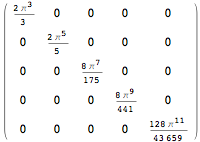This will not answer your question directly, but seems generally on-topic. I have replied to a similar question before on StackOverflow, producing a complete and general Gram-Schmidt process implelentation which I believe to be rather idiomatic for Mathematica. I then specialized it to polynomials. Since it is not going to be migrated, I will simply reproduce my answer here verbatim.
I will throw in a complete code for Gram - Schmidt and an example for function addition etc, since I happened to have that code written about 4 years ago. Did not test extensively though. I did not change a single line of it now, so a disclaimer (I was a lot worse at mma at the time). That said, here is a Gram - Schmidt procedure implementation, which is a slightly generalized version of the code I discussed here:
oneStepOrtogonalizeGen[vec_, {}, _, _, _] := vec;
oneStepOrtogonalizeGen[vec_, vecmat_List, dotF_, plusF_, timesF_] :=
Fold[plusF[#1, timesF[-dotF[vec, #2]/dotF[#2, #2], #2]] &, vec, vecmat];
GSOrthogonalizeGen[startvecs_List, dotF_, plusF_, timesF_] :=
Fold[Append[#1,oneStepOrtogonalizeGen[#2, #1, dotF, plusF, timesF]] &, {}, startvecs];
normalizeGen[vec_, dotF_, timesF_] := timesF[1/Sqrt[dotF[vec, vec]], vec];
GSOrthoNormalizeGen[startvecs_List, dotF_, plusF_, timesF_] :=
Map[normalizeGen[#, dotF, timesF] &, GSOrthogonalizeGen[startvecs, dotF, plusF, timesF]];
The functions above are parametrized by 3 functions, realizing addition, multiplication by a number, and the dot product in a given vector space. The example to illustrate will be to find Hermite polynomials by orthonormalizing monomials. These are possible implementations for the 3 functions we need:
hermiteDot[f_Function, g_Function] :=
Module[{x}, Integrate[f[x]*g[x]*Exp[-x^2], {x, -Infinity, Infinity}]];
SetAttributes[functionPlus, {Flat, Orderless, OneIdentity}];
functionPlus[f__Function] := With[{expr = Plus @@ Through[{f}[#]]}, expr &];
SetAttributes[functionTimes, {Flat, Orderless, OneIdentity}];
functionTimes[a___, f_Function] /; FreeQ[{a}, # | Function] :=
With[{expr = Times[a, f[#]]}, expr &];
These functions may be a bit naive, but they will illustrate the idea (and yes, I also used Through). Here are some examples to illustrate their use:
In[114]:= hermiteDot[#^2 &, #^4 &]
Out[114]= (15 Sqrt[\[Pi]])/8
In[107]:= functionPlus[# &, #^2 &, Sin[#] &]
Out[107]= Sin[#1] + #1 + #1^2 &
In[111]:= functionTimes[z, #^2 &, x, 5]
Out[111]= 5 x z #1^2 &
Now, the main test:
In[115]:=
results =
GSOrthoNormalizeGen[{1 &, # &, #^2 &, #^3 &, #^4 &}, hermiteDot,
functionPlus, functionTimes]
Out[115]= {1/\[Pi]^(1/4) &, (Sqrt[2] #1)/\[Pi]^(1/4) &, (
Sqrt[2] (-(1/2) + #1^2))/\[Pi]^(1/4) &, (2 (-((3 #1)/2) + #1^3))/(
Sqrt[3] \[Pi]^(1/4)) &, (Sqrt[2/3] (-(3/4) + #1^4 -
3 (-(1/2) + #1^2)))/\[Pi]^(1/4) &}
These are indeed the properly normalized Hermite polynomials, as is easy to verify. The normalization of built-in HermiteH is different. Our results are normalized as one would normalize the wave functions of a harmonic oscillator, say. It is trivial to obtain a list of polynomials as expressions depending on a variable, say x:
In[116]:= Through[results[x]]
Out[116]= {1/\[Pi]^(1/4),(Sqrt[2] x)/\[Pi]^(1/4),(Sqrt[2] (-(1/2)+x^2))/\[Pi]^(1/4),
(2 (-((3 x)/2)+x^3))/(Sqrt[3] \[Pi]^(1/4)),(Sqrt[2/3] (-(3/4)+x^4-3 (-(1/2)+x^2)))/\[Pi]^(1/4)}


Orthogonalize[x^Range[5], Integrate[#1*#2, {x, -\[Pi], \[Pi]}] &]$\endgroup$